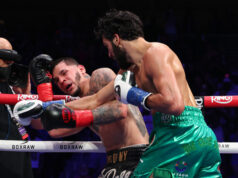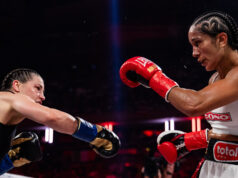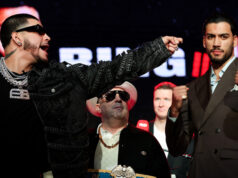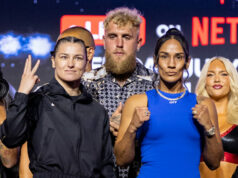How would Manny Pacquiao Stand up to the Challenges of Fighters Like Sugar Ray Leonard and Thomas Hearns?
Before matching Pacquiao against the greatest welterweights of all time, several considerations must be taken into account. First of all, Manny’s welterweight history has yet to be written. It stands to reason he will make at least several more appearances in the weight class, and with the caliber of opponents available he could conceivably throw this analysis into a different light a few years from now. As of now, his welterweight resume is good, but wins over a post-peak De La Hoya and Cotto do not in themselves suggest all-time welterweight greatness.
A majority of the all-time great welterweights just so happened to be large-framed fighters who would later find success at higher weight classes. Former Welterweight Champion Tommy Hearns, for example, would later go on to win titles at light heavyweight and even contend at cruiserweight. Manny, conversely, is more or less at his physical limit at welterweight, having once been a flyweight titleholder.
In these fantasy matches, Pacquiao will be fighting some of the greatest fighters of all time. No other division has more representatives in the all-time top 25 than the welterweight class. Some of the welterweights he is matched with here are fighters he may have already surpassed in historical terms. However, many of those fighters compiled stronger resumes specifically at welterweight, while Manny’s greatness is spread out over a mind-boggling seven divisions.
Let’s get started.
Fight #1:
Henry Armstrong
149-21-10 (101 KOs)
World Welterweight Champion (1938-1940)
Analysis: At least Pacquiao is not at a big size disadvantage here, as both had a 67” reach and Manny even had an inch of height on the legendary “Homicide Hank.” Armstrong had also first seen fame as a featherweight, so he is a division-hopper like Pacquiao. At one point Armstrong held 3 out of the eight world titles in boxing at the same time. He held almost 40% of all titles in the game at the same time! During this period, he was a juggernaut.
The question is how peak was Armstrong at 147? He sure did put together an impressive run of 19 defenses, including wins over Barney Ross, Ceferino Garcia, and Baby Arizmendi. His other challengers, though, could serve as telephone book filler. In addition, he lost a fight to Lou Ambers in the middle of his reign, and after a little more than 2 years as champion was twice beaten by Fritzie Zivic, and once by stoppage. Is it not reasonable to say Pacquiao has surpassed both Ambers and Zivic in historical terms? Armstrong is the more highly ranked fighter historically between him and Manny, but during his welterweight reign, he had started to reach the end of his rampaging ways, whereas Manny has kicked it into a new gear at this weight.
To characterize Armstrong by his losses to Ambers and Zivic is completely unfair, so we have to assume in these fantasy matches that both men will be at their best. In that event, this would be one hell of a fight. Manny’s speed and athleticism would be pitted against Armstrong’s strength and aggression. The clash in styles would make for a classic clash.
Armstrong would get nailed coming in, but Pacquiao would not be able to deter him forever. Manny would have to dig deep throughout to thwart the attacks of one of the most effective pursuers of all time. Manny would rely on his legs and would be forced to perform at a work rate that might exceed his comfort level. That was Armstrong’s bread and butter. I think Manny would have some success while still fresh and might hold a slight edge through eight rounds with his pinpoint counters and mastery of angles.
As Manny became more stationary, Armstrong would begin to trap him on the ropes and in the corners and do some damage. The early bodywork would begin pay dividends for Armstrong. By the 13th round, Pacquiao would be looking like a potential stoppage victim before lashing out with a straight left that rocked Armstrong to his core. Manny would pour it on and Armstrong would barely make it to the bell.
The frenetic pace would render both men gassed for the final two rounds, which would become a battle of heart more than craft. Each man would have his moments before the final bell sounded ending a classic fight.
Result: Draw (Might be a cop-out, but after breaking down two dozen of these Pacquiao fantasy matches, I should be able to call one a draw and this fight is as good a candidate as any.)
Fight #2:
Sugar Ray Robinson
173-19-6 (108 KOs)
World Welterweight Champion (1946-1951)
Analysis: Here we have Robinson, the greatest fighter of all time fighting at a weight where he was untouchable. In a decade at 147, Robinson beat 15 Hall of Fame members and put together a record of 95-1-2. His only loss was to middleweight Jake LaMotta, a fighter he beat five times. It doesn’t get any better than that. That’s why Sugar Ray Robinson is the clearest #1 in any division.
Filipino Bernard Docusen, who stylistically resembles Pacquiao perhaps more than any of Robinson’s other welterweight foes, gave Robinson a heated challenge. One would figure Pacquiao could bring a lot more heat to the Sugar Man than Docusen. To a large degree, he would. The first 5-6 rounds of this fight would be furious, with each man having success. Pacquiao would do well using his angles and speed, while the deadly accurate Robinson would rely on power and science over volume.
By the mid-rounds, Robinson would begin to hone in with combinations and Manny would begin to get raked. Robinson would be combining all the elements that made him great: power, speed, fury, ring IQ, and craftiness. Able to shoot from a distance with his 5” advantage in height and reach, Robinson would begin to pick Manny apart, and at the end of the 8th round, Freddie Roach would save Manny from taking further punishment in an unwinnable fight.
Result: Sugar Ray Robinson by 8th round TKO.
Fight #3:
Jose Napoles
81-7 (55 KOs)
World Welterweight Champion (1969-1970, 1971-1975)
Analysis: Napoles, known as “Mantequilla” meaning butter, was exactly that—a smooth boxing machine. He could rough up an opponent or out-finesse him with equal alacrity. The Mexico-based Cuban fled his communist homeland after pro sports were banned and toiled in Mexico for many years before shooting into prominence when he was already pushing 30 years of age.
Manny would be nearly as tall as Napoles, but “Mantequilla” would enjoy a 5” reach advantage. Able to match Manny’s blinding speed with perfect timing and good speed of his own, Napoles would enjoy an advantage during most of the action. Manny’s pure fighting spirit and slashing power would play into the fight increasingly, especially as he begins to notice he is falling hopelessly behind.
Napoles would be educated and shrewd enough to make the adjustment and begin to dial in his offense, knocking Manny down in the 9th round. With Pacquiao in deep peril, Freddie Roach cleverly instructs him to depend solely on speed and box and move, move, move. Over the next several rounds, Pacquiao forgoes trying to hurt Napoles and befuddles him with quick and sharp movement highlighted by quick jabs and one-twos.
At the final bell, Manny had built up so much positive momentum that there is a little suspense surrounding the decision, however, Napoles had won so many of the early and middle rounds that it was too big of a hole for Manny to dig out of.
Result: Jose Napoles by close unanimous decision.
Fight #4:
Pipino Cuevas
35-15 (31 KOs)
WBA Welterweight Champion (1976-1980)
Analysis: What a strange career Cuevas had. He didn’t start or finish well, but in the middle is a 4-year reign of destruction. At the tender age of 18 with a mediocre record of 15-6, he was given an undeserved title shot against WBA champ Angel Espada. After knocking him out in the 2nd round, he began a brutal run of 11 defenses that left a bunch of broken bones and crushed dreams in his path.
Cuevas’ M.O. was not extravagant. He tried to get you in position to begin hammering away with his power shots. He could wield his left hook with wrecking-ball affect. Many quality fighters who fell victim to Cuevas were never heard from again; so thorough was the physical battering he could dish out in his prime.
Pacquiao would not dare to engage Cuevas in a phone booth-type of fight. He would be too smart to relinquish all his advantages and give Cuevas his best chance to win. What Manny would have going for him in this match are his angles, speed, and boxing ability. Shifty boxers who could sustain movement for the course of the fight always troubled Cuevas. Quick-handed boxers could also befuddle the one-dimensional Mexican legend.
Pacquiao would taste Cuevas’ power early, which would only serve to force him to utilize his slashing style of in-and-out boxing. Cuevas power, pursuit, and just overall viciousness would keep him in the fight for the first half of the fight, but Manny would hold an edge going into the second half.
One of Pipino’s shortcomings would surface around this time, with catastrophic results. He often moved in straight lines. He would march straight in, and then back straight out. He would do it one too many times and Manny would zap him with a haymaker left as Cuevas was pulling out, unprotected. Cuevas would go down in a heap. After struggling to his feet, Manny would jump on him, whipping in punches until the referee saved Cuevas from the inevitable.
Result: Pacquiao by 9th round TKO.
Fight #5:
Sugar Ray Leonard
36-3-1 (25 KOs)
WBC Welterweight Champion (1979-1982)
Analysis: Say what you will about Leonard, who often catches some flack from fans, but he is a top welterweight in historical terms anyway you slice it. His welterweight resume includes wins over Hall of Fame inductees Wilfred Benitez (39-0), Roberto Duran (72-1), and Tommy Hearns (22-0). Among all other Welterweight Champions, Leonard’s list of victims is perhaps the most top-heavy of them all. In his first 15 years as a pro, he lost one fight, which he avenged. He was also one ill-advised comeback fight at 41 away from going his whole career without being stopped.
I’m not sure how many 5’6” fighters in history could hang with a prime Sugar Ray Leonard. Able to work with a 4” height advantage and a 7” reach advantage, Leonard would be able to comfortably work from a distance. Leonard, one of the best “speed fighters” of all time, would be at least able to match Manny’s speed, but with a such an edge in natural tools, he would be able to use his speed to greater affect.
I’m sure team Pacquiao would come up with a strategy so that Manny would not merely serve as a piece of lumber being fed into a wood chipping machine. Pacquiao’s talent and versatility would make it so Leonard would not just be able to cruise his way to victory. I don’t think it would help him early, as Leonard would work from he outside and start putting rounds in the bag.
Manny would keep trying, searching for ways to turn it around. Leonard’s high-energy boxing would leave him a little fatigued by the championship rounds, and Manny would be able to bang home some good left hands that would remove the smirk from Leonard’s face and swell him up a little bit. At the end, however, it would not be enough. Leonard would win a taxing, but wide decision.
Result: Sugar Ray Leonard by unanimous decision.
Fight #6
Thomas Hearns
61-5-1 (48 KOs)
WBA Welterweight Champion (1980-1981)
Analysis: We’ve done fantasy matches for Pacquiao spanning 5 divisions and over two-dozen fighters. Out of all of them, this is the worst possible match-up for Manny Pacquiao. The physical dimensions are alarming, as Hearns would have a 7” advantage in height and nearly an entire foot in reach! That in itself is not enough to beat a great like Manny. But when the guy holding those advantages is also one of the fiercest punchers of all time, it makes for a very difficult proposition for Pacquiao.
Manny would have to get inside, but in doing so, would be right in Hearns’ wheelhouse. Hearns could punch with both hands, especially the right, but could also crush ribs and faces with his left. He could stalk or box and move. In this fight, he would box, as Manny would only be able to do business on the inside.
Hearns’ legs would sometimes betray him in the face of a heated battle. His chin, while often dismissed, was not that bad, though it wasn’t great either. I just don’t see Pacquiao able to get inside enough to test Hearns without getting whacked out first. I think it would be interesting for the first few rounds.
In the third, however, Hearns would begin to time an advancing Manny with some right hands. A right-left would send Manny down at the end of the 3rd round. Coming out for the 4th, Manny would step it up in an effort to reverse the tide, and get nailed by a Hearns right that would put him down for the count.
Result: Thomas Hearns by 4th round knockout.
You can find the other Manny Pacquiao vs. The Greats articles below, so be sure to check them out. With the potential Pacquiao vs. Mayweather bout perhaps coming back around later this year, it’s interesting to see how Pacquiao would have held up against some of these all-time challenges.










